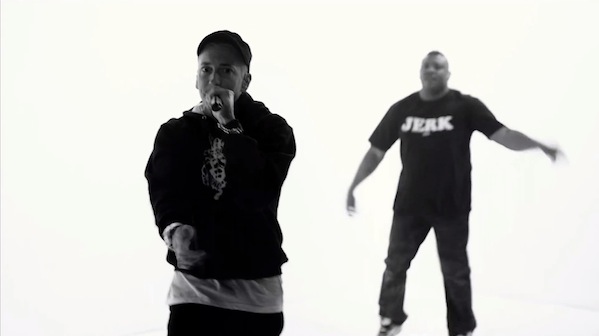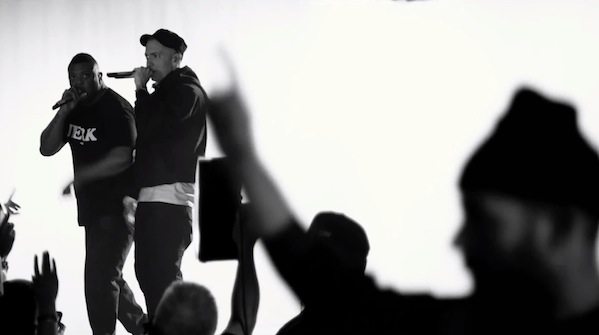No Cute Kittens Here: Spike Jonze's Staging of the YouTube Music Awards Delivers Something Unexpected
Last month, YouTube produced the first-ever YouTube Music Awards (YTMAs) to try to edge into MTV territory. Like the VMAs, the YTMAs were filmed in front of a live audience. The YouTube version, hosted by actor Jason Schwartzman and polyglot performer Reggie Watts, was also streamed live and included the usual awards show pranks and oddities like face painting, cake smashing, and copious amounts of fake blood. Filmed in the round at New York City's Chelsea Piers, the Web show's novelty, however, unfolded in the live music videos—stand-ins for standard staged performances—creative-directed by Spike Jonze. Arcade Fire's "Afterlife" became a short film by Jonze starring Greta Gerwig that was shot and edited in one take. Moodily lit and jumping from apartment interior to faux forest to the concert stage, the opening performance brims with the kind of goofy energy the actress is known for in her films. Love it or hate it, the entire show earned points for taking so many risks. At the other end of the spectrum was the slick, six-minute black-and-white live "Rap God" music video by Eminem (above) that closed the show. We spoke with its director James Larese, a co-founder of the LA-based collective Syndrome who directed Eminem's "Berzerk" and "Crack a Bottle" videos, about what it was like to take part in such a unique project.
StudioDaily: When did you first become involved in the show?
James Larese: Eminem's manager, Paul Rosenberg, called me up and asked me if I would direct Eminem's segment during the YouTube Awards. I had no idea what that meant but of course I said yes. I have a really good working relationship with them and when they've called on us before it's always been something fun. I was in Miami at the time on another job so I literally flew to New York—about a week out from the show—and just showed up at this location still not knowing what to expect. But I saw Spike Jonze and a whole building full of creatives who were putting this thing together. I came to find out that I wasn't the only one who was trying to figure it all out.
Was that awkward?
You know, there were no barriers and no fronting at all. Everyone was very open about the "Oh @#$t!" factor. At the same time, we were all very excited about it and you could feel the energy in the room. There was this rush knowing that we could be part of something really cool but also that it could fail miserably. Either way, I knew it would be a hell of an experience. The most exciting thing for me was the fact that you had all these other directors that I'm usually up against for jobs but in this case we were a united front and everyone was opening the doors creatively and helping each other out. The best way to describe it is like a really amazing summer camp!
Have you ever shot anything like this before? It seems like that was part of the experiment: put the music video folks into a live environment and see what happens.
Yea, I definitely think they wanted to see how we could change it up. The only thing live I'd ever done before this was watch a show! I'd done some things that required choreography, of course, and Syndrome has done a lot of stage graphics and post work for awards shows and live events, but all of it was predetermined and not done on the fly like this.
So what happened after you and the other directors arrived on location?
The thing that was interesting about the production setup was that they were going to have one crew that would do the whole show: four cameramen, one lighting guy, one art director/set dresser and basically 90 minutes to pull off six performances, plus the actual awards show itself. Each of the directors would have set times throughout the day when we would communicate with the crew and do camera blocking. They were really running around; it was a lot for the crew to handle. On the Tuesday before the show, I had my first blocking setup with everybody, including Spike, for a few hours. That was the daily regimen. But what was really cool was you could then sit in on other people's segments so you could absorb what they were doing but also chime in on any creative questions that came up.
What did you shoot with?
One of the reasons we could do this creatively—make a live shoot look filmic, for example—was to shoot with the F55, the new 4K camera with a Super 35 mm sensor from Sony. It was my first experience with the cameras. We had four Steadicams. I'd wanted originally to do handheld beause of the song but I soon realized that to ask the crew to change formats like that would be just too difficult. They only had about six minutes between each performance. There are no commercial breaks on the Internet! In the end, I think handheld would have been a little too kinetic because we incorporated the fans in the shots as well.
Were these hard-core Eminem fans or just those in the general audience?
We brought in about 100 of Eminem's fans to scatter around the perimeter of his stage setup. He'd never performed that song live and it's long, so some people didn't think he could do it live. A big part of our thinking was to let him do the whole thing to show what he could do with it and that this wasn't something that was chopped together in the studio. The fans ensured that the energy level was high. We did one run-through and a dress rehearsal with him on the day of the show. That was part of the excitement. I had a few tweaks and notes based on that rehearsal but that was it. We're not going to go back and edit anything. If mistakes happen, so be it; we wanted everyone to see that. Luckily it came together and both Em and Spike were really happy with it.
How did you build Eminem's stage?
We created a 30-foot cube with the fourth wall down, which is where the audience was, and we painted it half black and half white. We covered him with two cameras: one shooting into the black and one into the white to create two different lighting setups. The other cameras would go into specific positions as the song progressed. The point was to build up to the third verse, when we could reveal the crowd. It's exciting to watch him perform but it is a six-minute song and things could get monotonous. It was important to have a build and within such a minimal concept, the incorporation of the fans was also a nice finale to the energy of the entire show. Once he turned around and started performing to the crowd you really saw something you wouldn't get if this was just a video. I was in the trailer with the live show director and editor and I was cueing cameras, so we're switching it like a live edit, while watching on the various monitors. All four cameras were rolling 100 percent of the time.
Why Pier 36 at Chelsea Piers?
I think Spike just wanted to take it out of a traditional, seated auditorium. His original idea was to do the whole show in a warehouse. He just wanted it as raw and exposed as possible. What was so great about the setup was that each performance was in the round, on the perimeter of the pier, and the fans were in the middle. It was almost like an art show, with an element of performance art. Whenever the next performance was about to start, everyone would move over to that area. Sure, that made it kind of crude but also very different. That's exactly what Spike wanted. It was "anti-" everything in terms of an awards show. But it also happened to have Lady Gaga, Arcade Fire and Eminem. To watch Spike work, particularly the piece he did with Arcade Fire, was so memorable for me. It was my favorite piece in the show. Syndrome would probably never be mentioned in the same sentence with Spike Jonze if I hadn't taken part in this project, so I felt very fortunate to be able to see that organic process as it happened, to watch a real legend work. There were no closed sets. He pulled in people like Vanessa Hudgens and Michael Shannon on the fly.
What kind of music do you listen to?
I like it all but I'm really into jazz, so to me, this was sort of like a freestyle jam session that all the jazz greats are known for. That's actually how I work with Eminem most of the time. We come up with ideas and have this really great collaboration and then things really gel when we are actually shooting the videos. That's my favorite thing to do, to just get with an artist and discover those happy accidents through collaboration. That's what I love.
You can watch the entire 80-minute YouTube Music Awards here: http://www.youtube.com/watch?v=yXBPbnv1H-U.


